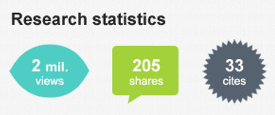FigShare: striving for greater efficiency in scientific research
17 Feb, 12 | by BMJ
Scientific publishing as it stands is an inefficient way to do science on a global scale. A lot of time and money is being wasted by groups around the world duplicating research that has already been carried out.
FigShare wants to change this. A data sharing platform where researchers can add figures that might otherwise go unpublished, FigShare has recently been relaunched following investment from Nature’s sister company, Digital Science. It allows researchers to publish all of their findings in an easily citable and discoverable manner.
“During my PhD I became very aware that a lot of my research data would never see the light of day outside my lab meetings. It made more sense to me to make all of my research data openly available,” said Mark Hahnel, founder of FigShare. As the first online repository for storing and sharing preliminary findings in the form of individual figures, datasets, media or filesets, users can post preprint figures to claim priority and receive feedback on findings prior to formal publication. In doing this, it is thought that other researchers will not duplicate the work, thus making research more efficient and releasing hidden, raw data.
By breaking research publications into their fundamental components, the research also becomes more discoverable, with search engines indexing each individual research object title rather than an all-encompassing title for the entire research project. This public data is then easily searchable and browsable, with the ability to view the most shared and viewed in each research field.
FigShare provides each researcher with 1GB of free private storage space, with the option to purchase further space apparently coming soon. This space can be used to manage research data and then make it available to the public with a click of a button. Until then, research objects are backed up in the cloud and accessible from anywhere. Researchers are encouraged to add descriptions, tags (e.g. grant numbers) and links to their uploads, to facilitate easy navigation through large amounts of research data.

FigShare concentrates on giving users credit for all of their research. By monitoring new measurements of impact, such as altmetrics, as well as traditional measures (i.e. citations), researchers receive a more comprehensive view of of their research.
As an expanding number of groups and organisations encourage researchers to release and share their data, it will be interesting to see how significant this tool will become in changing existing publishing practices.
